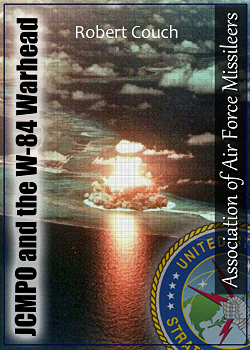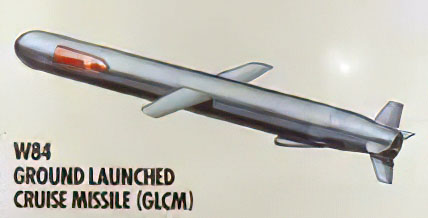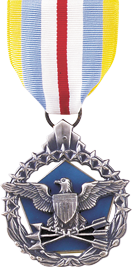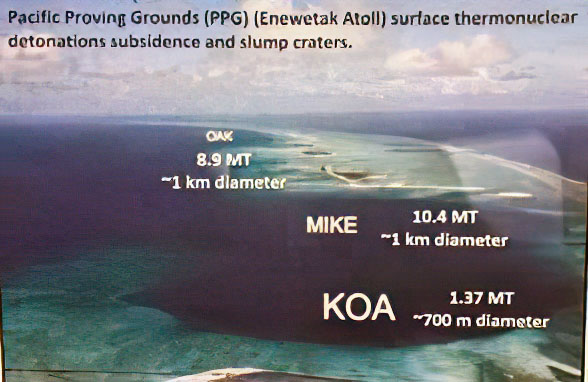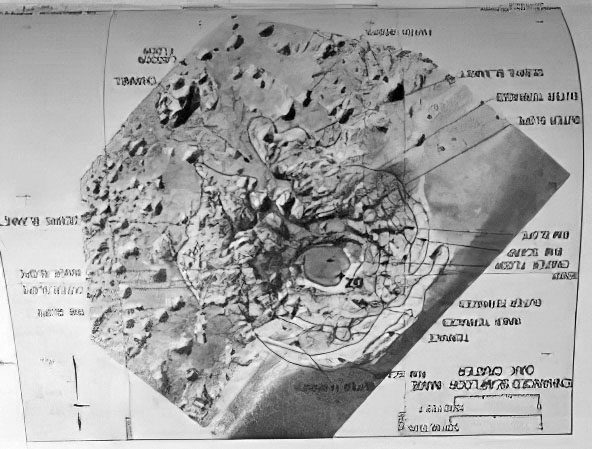|
|
|
|
|
Robert Couch
© «AAFM», March, 2021.
Our address: en@rvsn.info |
|
See also: «AAFM», March, 2021. Newsletter of «Association of Air Force Missileers»
Robert Franklin Couch Defense Superior Service Medal, 1987
The Secretary of Defense of the United States of America takes pleasure in presenting the Defense Superior Service Medal to Lieutenant Colonel Robert Franklin Couch, Jr., United States Air Force, for exceptionally superior service as Advanced Nuclear Weapons Effects Manager, Strategic Structures Division, Shock Physics Directorate, Defense Nuclear Agency, from May 1984 to April 1987. Providing innovative program leadership and effective technical resources management in the development and execution of a high-priority, multimillion dollar program, he led the Defense Nuclear Agency effort in the determination of crater formation in the Pacific Proving Ground and predicting the ground shock and cratering from modern nuclear weapons. He obtained previously unachievable results in nuclear crater research and Marine exploration by aggressively leading large technical and logistic teams in complex laboratory and field programs. He deleted costly options and rewrote contract specifications to save $6 million while leading a successful research program which proved that missile silos can survive nuclear bursts at ranges previously considered fatal. This has significantly improved the understanding of US-USSR strategic nuclear postures and has provided ground work for the next generation of nuclear weapons. The distinctive accomplishments of Lieutenant Colonel Couch reflect great credit upon himself, the United States Air Force and the Department of Defense.
In January 1982 I was at the Air Force Weapons Laboratory (AFWL) at Kirtland Air Force Base (AFB), NM. My primary specialty code was 2665, nuclear research officer and had previous exciting tours as an intel white coat Lab rat and analyst. With degrees in geology along with a Reserve Officer Training Corps commission with an Air Force Institute of Technology civilian institution program Masters, I headed up a group of scientists and engineers focused on nuclear weapons effects. Specifically focused on strategic structures and associated geologies of interest. I was finishing up looking at the geology investigation results of 23 western state valleys that were being proposed for Missile–X (MX), with200 missiles in a 4,600 race track shelter scheme in Western Basins for housing the mobile transporters of the MX missile. At the time it was a leading contender of multiple aim point ideas we had explored for the AF Ballistic Missile Office. In another scheme we were looking at various western geologies that might hide a deep underground MX missile complex. We were monitoring underground tunneling tests at the Nevada Test Site to see how a large tunnel boring machine actually performed. This intercontinental ballistic missile (ICBM) basing approach would be used to dig out for a launch from a secretive location after nuclear hostilities had been initiated. We were also supporting high explosive tests designed to develop and perfect predictive weapons damage codes focused on strategic structures and geologic contributions. These tests in-part were helping to better understand “beneficial siting and geology” for assessing structural hardness of a complete ICBM system. I was also digesting the recent data my team and I had collected overwater and underwater (think Jacques Cousteau or Navy SEALS) at Enewetak Atoll, the historic Pacific nuclear test site. This project focused on several very large 1950s megaton yield nuclear craters blasted into the reefs/islands and now flooded in shallow water. The weapons effects community and Strategic Air Command (SAC) could not calculate with existing predictive formulas and algorithms predicting the actual crater size and associated potential ICBM silo killing ground shock impulses generated by these excavated huge megaton-created craters. New, emerging first principle computational codes indicated the craters should be much smaller and with less ground shock. We were trying to figure out the huge discrepancy by understanding how the craters formed in this unique marine setting. We were also privy with alarm to what the Russians were doing in this arena to protect missile silos. In April 1982, AFWL was tapped to urgently provide a nuclear warhead officer for an important new system. My exposure to the historic nuclear weapon development and testing in the Pacific, led somebody to suggest I might be a good fit to help out with Department of Energy’s (DOE) struggles to field a new nuclear weapon package. I soon received a call from Gen Robert Marsh, Commander, Air Force Systems Command (AFSC). I could not believe he remembered me from way back at my first AF assignment as a lieutenant way down in his chain of command 10 years past! He mentioned he was a Matador and Mace Program Manager back in the ‘50s and that there was now a follow-on of a hot little new cruse missile needed in Europe. He also said he had a nuclear munitions background appreciating the challenges DOE was having with building a new nuclear device but their progress chart he reviewed every month was all red. He wanted me to go to Crystal City, VA, to ensure the new Ground Launch Cruise Missile (GLCM) got its nuclear warhead on time for the fast-paced deployment to North Atlantic Treaty Organization (NATO) countries. The DOE was struggling to meet the first warhead delivery schedules for Initial Operational Capability (IOC). He wanted me to help turn that chart to green! I had never heard of the GLCM, or Crystal City for that matter, and wondered if this was some sort of backwater job. Crystal City conjured up a sci-fi glass fantasy metropolis to me. I agreed to go at his insistence, saluted smartly over the phone, and said I would rush to Washington, DC, as soon as possible. He assured me it would be rewarding and important assignment, but I was not convinced. Surely a System Program Office (SPO) slot was going to be a bore and I’d be sitting behind some desk pushing papers. It was not geology! Ok, so it was definitely not geology, but I was very wrong on the boring part! My change of station orders showed up that very next week for the Joint Cruise Missile Program Office (JCMPO) and noted that I report in 3 weeks! I quickly started to do my homework on what JCMPO was all about. What was GLCM? What was so special about this new W-84 warhead? In June 1982, arriving at the Crystal City’s Navy Air System Command’s offices that housed the JCMPO on the 11th floor of a nondescript office highrise, I first was escorted by a Navy petty officer to what was to be my cubbyhole. The dreaded desk did have a window. Then I met my immediate nuclear focus team and learned my position was actually a Navy engineer’s billet. I was to track the W-84 progress at the DOE Complex, address issues with meeting the new IOC of December 1983 and help the JCMPO payload team with the nuclear certification process which was also challenged to meet IOC. Lots of TDY would be in the offering, starting soon. The GLCM SPO as I found it, had Col Ron Couture in charge who reported to the JCMPO Adm Locke and AFSC’s Gen Marsh with AFSC Vice Commander Lt Gen Robert Bond tracking GLCM. Small teams of Air force officers with a minimum support staff headed up six GLCM Division Subsystems. The subsystems were: All-Up Round, Transporter Erector Launcher (TEL), Launch Control Center (LCC), Logistics Support, Operations, Basing and Personnel, and Mission Planning. My team of five officers, headed by Lt Col Ed Hamilton, was a somewhat overarching independent group looking across the whole system and specifically at nuclear certification, safety issues, configuration control disconnects and payload issues. So what was JCMPO anyway? In January 1977 the Defense System Acquisition Review Council providing advice to the Secretary of Defense (SecDef), who generally took their advice, mandated a joint Air Force-Navy project office to streamline acquisition management of the developing family of related but individually distinct missiles underway by both services. The program office was headed up by a Rear Adm Walter Locke who would be replaced in August 1982 by Adm Stephen Hostettler. The Navy SPO had a charter to provide a nuclear air launched cruise missile (ALCM) for the Air force and a ship and submarine launched version (SLCM) for the Navy. The Navy also envisioned a nuclear, conventional, air launched (medium range Air to surface missile (MRASM) and anti-ship version of the General Dynamics (GD) Tomahawk cruise missile. The basic GD missile had been in development since the mid 70s. It was no coincidence that the missile looked like a torpedo with wings. The Navy had a prototype of the GD SLCM under contract in 1976.The nuclear strategic ALCM was also in development with a Boeing prototype developed from a cruise armed decoy. The final ALCM missile design was to be chosen by a fly-off between GD and Boeing. GLCM emerged as a nuclear tipped version of SLCM conveniently filling a reemerging role that might fill gaps left by previous retired European deployed Intermediate Range Ballistic Missiles (IRBM).
Importantly GLCM and a new Army Pershing upgrade addressed a 1977 response to the emerging Soviet mobile, accurate, long range, and multi warhead SS-20 that was threatening most of Europe was underway. Cruise missile technology had matured significantly in the early 1970s with advances in miniaturization of guidance components, small reliable jet engines and significantly more compact efficient nuclear warhead packages. The new cruise missile arrival was an attractive, affordable, low risk option for the services to supplement ballistic missiles and bombers. However the air breathing cruise was not universally embraced by the rank and file aviators who didn’t want competition to their mission. An often asked question on the GLCM mission as to why it was not to be an Army ground pounder role? The Air Force got the 1,500 mile range mission because back in 1956, SecDef Wilson directed the Army to stand down with efforts to develop long range missiles that exceeded 200 miles. This edict helped resolve major service responsibilities debates and institutional conflicts at the time with Mace and Matador ranges and the Army’s Jupiter/Redstone medium range ballistic missile. Army’s Pershing 1 missile improvements latter crept up to an almost 400 mile range from the initial 100 mile range. The new Pershing II range was waived to address the dual track NATO GCLM/Pershing II policy and the employment and development that could take advantage of the Pershing I infrastructure already fielded.
By mid-1977, JCMPO staff grew to over 300, half USAF, mostly blue suiters, and the other half mostly Navy civilians, all under Adm Locke. The Navy and Air Force had to work out many incompatibilities, like funding approaches, command chain and differences in contracting and acquisition approaches. This Joint management approach provided control over configuration and maximum component commonality reducing vendor numbers and oversight. However for various reasons Boeing was selected for ALCM and over 100 JCMPO USAF staff moved back to Wright-Patterson AFB, OH, ALCM SPO. However the Air Force agreed to keep, for the Boeing ALCM, the engine, most of guidance and the compact W-80 warhead provided by Los Alamos for SLCM. The smaller Navy/Air Force contingent was left to focus on developing the SLCM/GLCM. Their job was refining the missile, the command and control process, the transportation system, the basing and protective shelters, manning, training and logistics. The W-80 warhead was already in development since 1976 by DOE for SLCM and would be just plug into the ground launch Tomahawk. But this was not to be the case, and changes filled Gen Marsh’s “red lined meatball chart.”
After a more complete understanding of the GLCM concept of land operations started to unfold and GD trade off studies emerged, big issues showed up. It became obvious to the DOE labs, the Military Liaison Committee (MLC) and the W-80 warhead project officers group that the Military Characteristics (MC) and Stockpile to Target Sequence (STS) being formalized for the W-80 use in SLCM and ALCM was incompatible with GLCM’s envisioned ground mobile employment. The MC was the formal Department of Defense (DOD)-DOE requirements process that looked at how the weapon would be employed. This detailed classified document covered all aspects and purpose of the weapon and required by DOD and what was achievable by DOE. The STS was a corollary to the MC which looked at the operational and logistical environment and associated risks the system would see in its fabrication to decommissioning lifetime. The W-80s to be employed in the ALCM and SLCM (latter called TLAM in the conventional warhead version) were in relatively benign and controlled operational environments. This GLCM weapon was going to live in a potentially very hostile environment riding around in the friendly or not so friendly countryside under a whole host of threats and ugly possibilities not encountered by ALCM or SLCM. The USAF safety community had huge concerns and saw a daunting task of nuclear certification for so many pieces of the complex support equipment and employment scenarios with a schedule that seemed highly optimistic, if at all possible, by May 1982. Fuzing options and yields for more targeting flexibility were needed for NATO role than what was currently on the W-80 in the strategic role. In the late 60s and more recent DOE nuclear weapon safety studies had strongly recommended emerging safety and security design philosophy and technology be installed wherever feasible in any new system. These features were now available to use to address the long list of concerns identified in the GLCMs deployment. Getting these features in one warhead was considered herculean given the time constraints and testing necessary for GLCM IOC. But in 1978 DOE labs said they could do this with extraordinary effort. This would be essentially a seriously modified or new warhead incorporating all these new safety design approaches and specialized components fresh from the drawing board. The task was assigned to Livermore Labs and their most esteemed bomb designer was tasked to lead the challenging effort. Dr Seymour Sack had a resume of successful bomb designs, had been responsible for smaller, compact systems and was known for getting things impossible done! He was to be the designer and director. Importantly, he advocated for, and then went on to develop many of the proposed safety features. He started with a highly modified cousin of W-80 that would use Los Alamos mature B61 design aspects as a baseline to install all eight safety features, hopefully feasible in time. These features included: insensitive, plastic bonded high explosive; Fire Resistant Pit; Enhanced Nuclear Detonation Safety (ENDS/EEI) with detonator strong-links; Command Disable; and the most advanced digital Permissive Action Link (PAL F) envisioned. The warhead had to be rugged and road worthy with attention to access denial and exposure to a multitude of abnormal environments. These all had to be designed and tested in a new package. It turns out the W-84 is the only device in the nuclear inventory to date with all the recommended safety features installed. The Pershing II W-85 had some of them installed as well, and future refits and refurbishments for other inventory systems would be so fitted, but the W-84 remains the only inventory weapon to capture all the features. In my new Navy JCMPO position, I spent time at DOE offices of Military Applications in Germantown and in the DOE headquarters in the Forrestal building, learned how the national and NATO command system worked for this new mobile system at the National Security Agency and the Pentagon. I also visited with the warhead’s Livermore design team and the prime storied design leader Dr Sack (who insisted and ensured that the W-84 was the safest/ securest nuke ever fielded), and on road trips gave pep talks at the DOE Texas (Pantex) and Kansas City production facilities that were working 24/7 to hand-build enough of this sophisticated weapon to make the first IOC, a politically fixed and immovable date. I attended eight Project Officers Group (POG) meetings and made seventeen European trips to all the GLCM bases present and future. I also monitored weapon fusing and flight tests over Naval Air Station China Lake, CA, and Dugway Proving Ground, UT); attended the Site Activation Task Force Meetings in England and Germany; reviewed the nuclear weapon safety analysis and key standard operating procedures; and was a critical field observer at the Fort Smith, AK, and Fort Lewis, WA, deployment exercises that focused on physical security and nuclear weapon surety. As in observer, with clipboard in the rain, I watched Army special ops forces take over a fielded GLCM site. I went on to make suggestions as how to better protect the missiles. I flew from London to San Diego, for an urgent fix for a connectr that the weapon maintenance team found did not fit at Royal Air Force Greenham Common. I was sent to Portland, OR, to help Hyster, Inc., a heavy equipment company, figure out how to come up with a nuclear certified forklift. Then there were the rodents hungrily eating the fiber optic cables running from the LCC and the TEL. I watched a GD TEL test burn up the hydraulic piston in a multi-cycle test in a scenario not envisioned in the original design. A fix was found by changing to synthetic lubricants. There were irregular components that did not mate together in the final physics package assembly at Pantex in the last hours of assembly. Some of my fond JCMPO memories include $600 dollar warhead wrenches that got Congressional attention citing them as an example of the high cost of nuclear weapons! This, too, was an example of DOE costs not captured in the DOD acquisition cost. I directly reported every month to my boss, sometimes, to the new Adm Hostettler prior to IOC, and to Richard Pearl, Assistant SecDef for International Security policy, on the warhead delivery and DOE status or any other big issues of interest to the SecDef. The chain of command was pretty short at JCMPO. In many ways, our surety and warhead team operated independently in the organization as we tried to ensure there were no fatal flaws or issues that could waylay deployment. There were many bumps in the road for the warhead as the missile and associated systems but these were solved by the army of driven DOE engineers, dedicated contractors and an outstanding blue suit team. Everything needed to get nuclear certified got certified or appropriately addressed. We made the Greenham IOC just fine in 1983, out of breath but jubilant thanks to the efforts of hundreds of individuals working around the clock for the just-in-time December 1983 W-84 deliveries. On my last watch in August 1984, as I prepared to moved to my next assignment, there was the underground nuclear test at the Nevada Test Site of Fusileer-Correo, a low yield nuclear option, that demonstrated that the W-84 actually worked with all its safety features in place! Despite many failed historical DOD attempts at Joint programs and despite the Navy and Air Force having different approaches to acquisition, not to mention legacy rivalries, the JCMPO effort seemed to be a success from my perspective. Although the nuclear tipped Tomahawks have come and gone, honorably serving as negotiated set pieces, the conventional Tomahawk has become the go-to missile in all recent conflicts. Despite my earlier misgivings, the assignment was anything but boring, incredibly rewarding and educational, with lots of beautiful European countryside, piles of frequent flyer miles and I finally got my basic missile badge. Looking back now I’m very proud to be a part of Cold War history!
|
